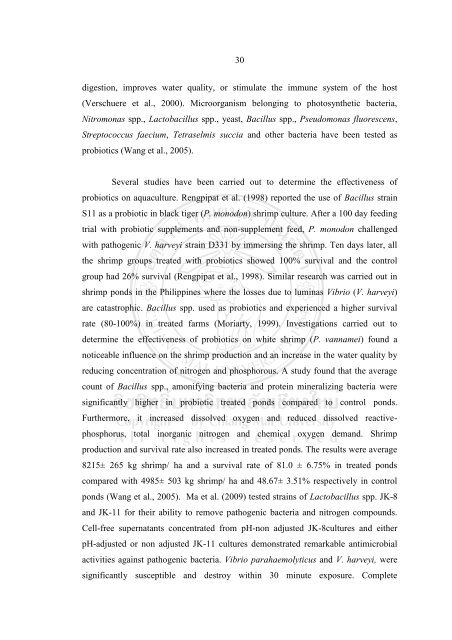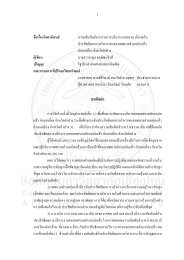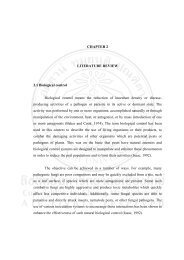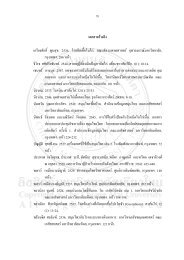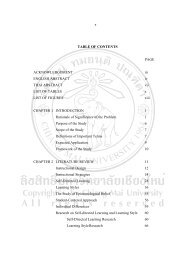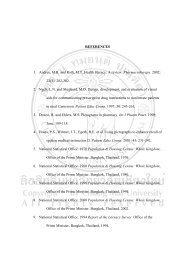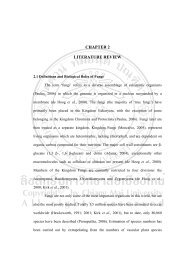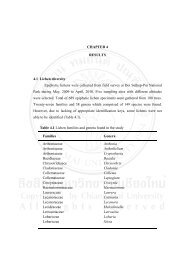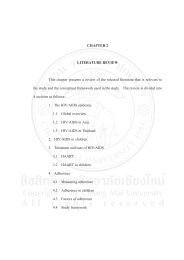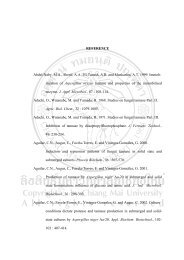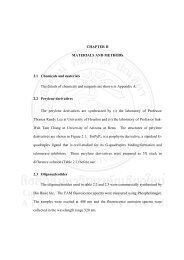prevalence and molecular characteristics of vibrio species in pre ...
prevalence and molecular characteristics of vibrio species in pre ...
prevalence and molecular characteristics of vibrio species in pre ...
Create successful ePaper yourself
Turn your PDF publications into a flip-book with our unique Google optimized e-Paper software.
30<br />
digestion, improves water quality, or stimulate the immune system <strong>of</strong> the host<br />
(Verschuere et al., 2000). Microorganism belong<strong>in</strong>g to photosynthetic bacteria,<br />
Nitromonas spp., Lactobacillus spp., yeast, Bacillus spp., Pseudomonas fluorescens,<br />
Streptococcus faecium, Tetraselmis succia <strong>and</strong> other bacteria have been tested as<br />
probiotics (Wang et al., 2005).<br />
Several studies have been carried out to determ<strong>in</strong>e the effectiveness <strong>of</strong><br />
probiotics on aquaculture. Rengpipat et al. (1998) reported the use <strong>of</strong> Bacillus stra<strong>in</strong><br />
S11 as a probiotic <strong>in</strong> black tiger (P. monodon) shrimp culture. After a 100 day feed<strong>in</strong>g<br />
trial with probiotic supplements <strong>and</strong> non-supplement feed, P. monodon challenged<br />
with pathogenic V. harveyi stra<strong>in</strong> D331 by immers<strong>in</strong>g the shrimp. Ten days later, all<br />
the shrimp groups treated with probiotics showed 100% survival <strong>and</strong> the control<br />
group had 26% survival (Rengpipat et al., 1998). Similar research was carried out <strong>in</strong><br />
shrimp ponds <strong>in</strong> the Philipp<strong>in</strong>es where the losses due to lum<strong>in</strong>as Vibrio (V. harveyi)<br />
are catastrophic. Bacillus spp. used as probiotics <strong>and</strong> experienced a higher survival<br />
rate (80-100%) <strong>in</strong> treated farms (Moriarty, 1999). Investigations carried out to<br />
determ<strong>in</strong>e the effectiveness <strong>of</strong> probiotics on white shrimp (P. vannamei) found a<br />
noticeable <strong>in</strong>fluence on the shrimp production <strong>and</strong> an <strong>in</strong>crease <strong>in</strong> the water quality by<br />
reduc<strong>in</strong>g concentration <strong>of</strong> nitrogen <strong>and</strong> phosphorous. A study found that the average<br />
count <strong>of</strong> Bacillus spp., amonify<strong>in</strong>g bacteria <strong>and</strong> prote<strong>in</strong> m<strong>in</strong>eraliz<strong>in</strong>g bacteria were<br />
significantly higher <strong>in</strong> probiotic treated ponds compared to control ponds.<br />
Furthermore, it <strong>in</strong>creased dissolved oxygen <strong>and</strong> reduced dissolved reactive-<br />
phosphorus, total <strong>in</strong>organic nitrogen <strong>and</strong> chemical oxygen dem<strong>and</strong>. Shrimp<br />
production <strong>and</strong> survival rate also <strong>in</strong>creased <strong>in</strong> treated ponds. The results were average<br />
8215± 265 kg shrimp/ ha <strong>and</strong> a survival rate <strong>of</strong> 81.0 ± 6.75% <strong>in</strong> treated ponds<br />
compared with 4985± 503 kg shrimp/ ha <strong>and</strong> 48.67± 3.51% respectively <strong>in</strong> control<br />
ponds (Wang et al., 2005). Ma et al. (2009) tested stra<strong>in</strong>s <strong>of</strong> Lactobacillus spp. JK-8<br />
<strong>and</strong> JK-11 for their ability to remove pathogenic bacteria <strong>and</strong> nitrogen compounds.<br />
Cell-free supernatants concentrated from pH-non adjusted JK-8cultures <strong>and</strong> either<br />
pH-adjusted or non adjusted JK-11 cultures demonstrated remarkable antimicrobial<br />
activities aga<strong>in</strong>st pathogenic bacteria. Vibrio parahaemolyticus <strong>and</strong> V. harveyi, were<br />
significantly susceptible <strong>and</strong> destroy with<strong>in</strong> 30 m<strong>in</strong>ute exposure. Complete


